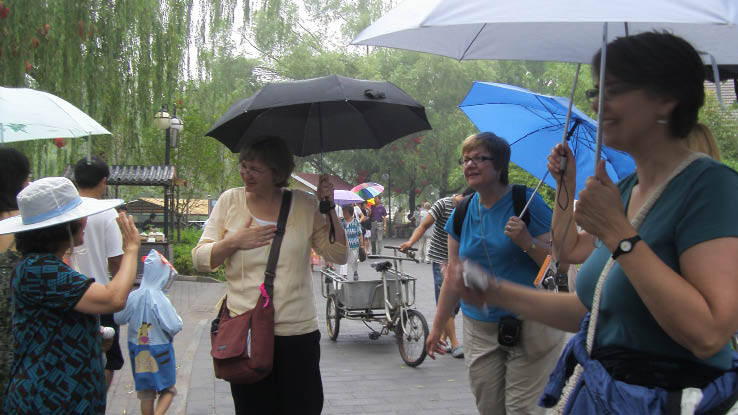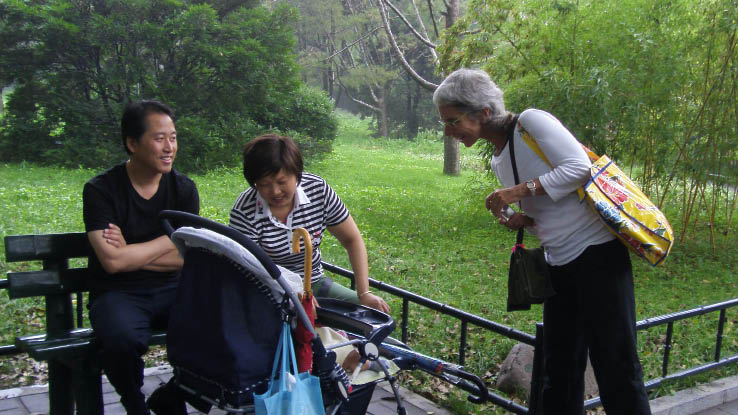| Teachers Are Human Bridges
By staff reporter ZHANG XIAOGUO
CONNOR Warner is a high school teacher of world history in Stevensville, a small town in Montana. "My students, like most kids that grow up in small places, are curious and eager to know about the outside world. Therefore I always try to expand my knowledge base and improve my classes; hopefully I can become a better resource for my students," says Connor.
That's why he registered for the National Consortium for Teaching about Asia (NCTA) seminar, which is designed to encourage and facilitate teaching and learning about Asia. Since 1998 when the program was founded, it has benefited more than 13,000 teachers around the U.S. A special feature of the program is a study tour to one of the Asian countries to help participants acquire firsthand knowledge and materials. And this time it was China.
 |
| American teachers sending their greetings to Chinese people in a park in Beijing. |
When the plane from the U.S. touched down at Beijing's Capital International Airport, Connor and 14 other teachers alighted for their first visit to China.
In their two-week trip, they would visit Beijing, Yunnan Province – a great place to see wonderful natural scenery and experience authentic ethnic minority cultures, and Shanghai, where the World Expo was in full swing.
The oppressive heat and humidity during Beijing's hottest July on record did not dint their enthusiasm. They spent their first two days in China visiting the capital's historic sites, including the Temple of Heaven, Tian'anmen Square, Forbidden City and Mutianyu, a famous section of the Great Wall, receiving an in-depth introduction to some of China's history and traditional cultural elements, such as elaborate fengshui designs and ancient, superbly crafted architecture. But the highlight of their time in Beijing was undoubtedly a visit to a park on the third day, where they had an opportunity to observe locals at leisure. Most had read about Chinese retirees doing morning exercise. Even so, they were still surprised by the bustling scenes in the park: elderly people were participating in martial arts, singing and dancing and other activities. The American teachers received friendly invitations to join the locals in their exercise. At that moment, language barriers dissolved.
 |
| Tese saying hello to a cute Chinese baby in a park in Beijing. |
As the party traveled to Yunnan and Shanghai, they took every opportunity to see more and exchange ideas with local people, thereby adding to their understanding of China. "I was impressed with the beauty of the mountains and the richness of the plants and animals in Yunnan, also with the expansiveness of Shanghai. I was surprised to see so many families from all over China vacationing in Yunnan or visiting Shanghai Expo," said Kim Rott, from Montana.
Kate Hennessy-Fiske was also taken by Chinese contrasts. "In Beijing and Shanghai I felt the fast-paced development and mind-boggling size and expansion. But when I got to Yunnan I saw the enormous contrast between urban and rural areas. I was also impressed with the sense of pride that so many Chinese people openly exhibit in their culture and history."
For Connor Warner, the thing that will stick most in his mind from this visit is the sound of pile drivers. "No matter where we went, something was under construction. From skyscrapers in Shanghai to the subway in Kunming, the China I saw was under construction."
The tour did give Kim and her companions inspiration for their teaching about China. All along the way they were eager to share their plans with each other. "The photographs from the Forbidden City and the Great Wall will be excellent additions to my PowerPoint presentations. Nothing gets the kids quite as excited as seeing a picture of someone they know (in this case, me) in one of the historic places," said Connor Warner.
"I would like to incorporate what I learned about the Ancient Tea-horse Trail in Yunnan into my history classes," says Nancy Lindeberg, from Maywood Middle School in Renton, Washington.
Kate Hennessy-Fiske planned to teach a unit in her world history class that looks at generational change in China. "I want to use the materials gathered from the seminar and the trip to better introduce major transition points in modern Chinese history and hopefully my class will really stimulate my students' curiosity to learn more."
Kim Rott considered creating a math study lesson in using abacus and also collaborating with the teachers of nutrition classes to help students research Chinese food and customs, and make those dishes themselves. In addition, she thought she could lead students doing Mandarin Chinese in research projects about various aspects of China, such as the Three-Gorges Dam and the Nanking Massacre during World War II, as back-up to their language studies. It seems these teachers just couldn't wait to carry out their plans.
The fruitful results of the study tour sound really encouraging. To some extent, teacher-targeted education is of the same importance as student-targeted education. Good training is able to inspire teachers in ways they never envisioned, which will help improve their teaching techniques and enrich their lesson content. In this case, the teachers returning to the U.S. not only implant images of China in the heads of their American students, but also serve as human bridges between China and the younger generation of Americans. Their efforts will build bonds that transcend borders and will lay solid foundations for the building of more positive and stronger links between the two peoples. | 